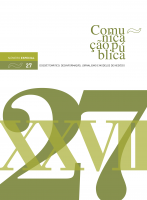In transition through the boundaries of Journalism
DOI:
https://doi.org/10.4000/cp.5522Keywords:
journalism, professionalization, boundary, ethics, transparencyAbstract
The construction of journalism as a profession implied the definition of a specific territory and the demarcation of its boundaries, in order to include the legitimate workers of the job and to exclude all the others. But these boundaries are becoming porous and threatened by neighbouring activities that demand to be treated like the journalists that own a professional license. Besides that, different media have been developing a variety of ‘products’ that somehow look like journalism, but in fact are pieces of advertisement (content marketing). Together with this trend, a number of professional journalists are moving to jobs belonging to the domain of the so-called “strategic communication” or “persuasive communication”, which causes some confusion in the public about “who is who”. In this article, we reflect about these new trends and present the results of a survey among professionals that left journalism for other communication jobs, trying to understand their motivations and expectations.
Downloads
References
Abbott, A. (1988). The System of Professions - An Essay on the Division of Expert Labour. Chicago, Estados Unidos da América: The University of Chicago Press.
Benton, J. (2014). Like it or not, native advertising is squarely inside the big news tent [online]. Nieman Journalism Lab. Disponível em: <http://www.niemanlab.org/2014/09/like-it-or-not-native-advertising-is-squarely-inside-the-big-news-tent/#disqus_thread> [Consult. a 15 de outubro de 2017].
Coutinho, C. P. (2018). Metodologia de Investigação em Ciências Sociais – Teoria e Prática. Coimbra, Portugal: Almedina.
Fidalgo, J. (2016). Disputas nas Fronteiras do Jornalismo. In ERC,Digital Media – Portugal – ERC 2015 (pp. 35-48). Lisboa, Portugal: ERC.
Fidalgo, J. (2008). O Jornalista em Construção. Porto, Portugal: Porto Editora.
Foremski, T. (2010). Welcome - When Every Company Is A Media Company... [blogue online]. Disponível em: <http://www.everycompanyisamediacompany.com/every-company-is-a-media-/2010/03/welcome-when-every-company-is-a-media-company.html#more> [Consult. em 10 de setembro de 2018].
Gieryin, T. (1983). Boundary-Work and the Demarcation of Science from Non-Science: Strains and Interests in Professional Ideologies of Scientists. American Sociological Review, 48 (6) (Dezembro 1983), pp. 781-795. DOI : 10.2307/2095325
Jarvis, J. (2016). Real Ads, Fake News, Real Confusion [online]. Disponível em: <https://medium.com/whither-news/real-ads-fake-news-real-confusion-18f97b230ef9 > [Consult. em 10 de setembro de 2018].
Kovach, B.& Rosenstiel, T. (2004). Os Elementos do Jornalismo. Porto, Portugal: Porto Editora. [Edição original: EUA, 2001].
Larson, M. (1977). The rise of professionalism – A sociological analysis. Berkeley, Estados Unidos da América: University of California Press.
Lasica, J.D. (2013). Journalists’ big switch - More companies are hiring scribes to ramp up ‘content plays [online]. Medium.com. Disponível em: < https://medium.com/@jdlasica/journalists-big-switch-3f298625876b> [Consult. em 15 de outubro 2018].
Lewis, S. (2013). The Tension Between Professional Control and Open Participation – Journalism and its boundaries. Information, Communication & Society, 15 (6), pp. 836 – 866.
Kunelius, R. (2016). Free Speech at an Intersection. Notes on the contemporary hybrid public sphere. In Carlson, U., Freedom of Expression and Media in Transition, Gothenburg, Suécia: Nordicom, pp. 35-42. (Versão PDF disponível em: https://www.nordicom.gu.se/en/publikationer/freedom-expression-and-media-transition>).
Meyer, M. C. (2014). Should journalism worry about content marketing? Corporate brands now compete for audience with an aggressive storytelling strategy. Columbia Journalism Review, Dezembro 2014. (Disponível online em: <http://www.cjr.org/innovations/should_journalism_worry_about.php>).
Rosen, J. (2006). The People Formerly Known as the Audience [online]. PressThink. Disponível em: < ttp://archive.pressthink.org/2006/06/27/ppl_frmr.html>[Consult. em 19 de setembro de 2014].
Ruellan, D. (1997). Les “pro” du journalisme – De l’état au statut, la construction d’un espace professionnel. Rennes, França: Presses Universitaires de Rennes.
Sparrow, P. (2014). Let’s Start Talking About a Radically Different Future of News. American Journalism Review, Outubro 2014, s/p. Disponível online em: <https://ajr.org/2014/10/28/radically-different-future-news/> [Consult. em 15 de outubro de 2018].
Stearns, J. (2013). Acts of Journalism – Defining Press Freedom in the Digital Age [online]. FreePress. [Disponível em: <http://www.freepress.net/sites/default/files/resources/ Acts_of_Journalism_October_2013.pdf> [Consult. em 10 de março de 2016].
Tenenboim-Weinblatt, K. (2009). Jester, Fake Journalist, or the New Walter Lippman? Recognition Processes of Jon Stewart by the U.S. Journalistic Community. International Journal of Communication, 3 (209), pp. 416-439.
Downloads
Published
Issue
Section
License
Copyright (c) 2019 Direitos do Autor (c) 2019

This work is licensed under a Creative Commons Attribution-NonCommercial 4.0 International License.
Os conteúdos da Comunicação Pública estão licenciados com uma licença Creative Commons - Atribuição-NãoComercial 4.0 Internacional.


